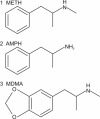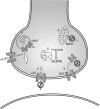The need for speed: an update on methamphetamine addiction
- PMID: 16951733
- PMCID: PMC1557685
The need for speed: an update on methamphetamine addiction
Abstract
The psychostimulant methamphetamine (MA) is a highly addictive drug that has surged in popularity over the last decade in North America. A burgeoning number of clandestine drug laboratories has led to dramatic increases in MA production, which have resulted in significant public health, legal and environmental problems. Current evidence indicates that exposure to MA is neurotoxic, and neuroimaging studies confirm that long-term use in humans may lead to extensive neural damage. These physiological changes are commonly associated with persistent forms of cognitive impairment, including deficits in attention, memory and executive function. In the present review, we provide a comprehensive description of the factors relating to MA use and the major health-related consequences, with an emphasis on MA-induced psychosis. It is hoped that increased knowledge of MA abuse will provide the basis for future treatment strategies.
La méthamphétamine (MA), un psychostimulant, est une drogue très toxicomanogène dont la popularité a grimpé en flèche au cours de la dernière décennie en Amérique du Nord. Des laboratoires clandestins de plus en plus nombreux ont entraîné des augmentations spectaculaires de la production de MA et, par conséquent, d'importants problèmes pour la santé publique, la loi et l'environnement. Les données actuelles indiquent que l'exposition à la MA est neurotoxique et des études de neuro-imagerie confirment que l'utilisation chronique chez l'être humain peut causer des dommages nerveux étendus. On établit couramment un lien entre ces changements physiologiques et des formes persistantes de déficience cognitive, y compris des déficits de l'attention, de la mémoire et de l'exécution. Nous présentons dans cette analyse critique une description détaillée des facteurs reliés à l'utilisation de la MA et ses principales répercussions sur la santé, en insistant sur la psychose causée par la MA. On espère qu'une meilleure connaissance de l'abus de MA servira de base à de futures stratégies de traitement.
Figures



References
-
- Sulzer D, Sonders MS, Poulsen NW, et al. Mechanisms of neurotransmitter release by amphetamines: a review. Prog Neurobiol 2005;75:406-33. - PubMed
-
- Nordahl TE, Salo R, Leamon M. Neuropsychological effects of chronic methamphetamine use on neurotransmitters and cognition: a review. J Neuropsychiatry Clin Neurosci 2003;15:317-25. - PubMed
-
- Izenwasser S. The role of the dopamine transporter in cocaine abuse. Neurotox Res 2004;6:379-83. - PubMed
-
- Brown JM, Hanson GR, Fleckenstein AE. Regulation of the vesicular monoamine transporter-2: a novel mechanism for cocaine and other psychostimulants. J Pharmacol Exp Ther 2001;296:762-7. - PubMed
Publication types
MeSH terms
Substances
LinkOut - more resources
Full Text Sources
Medical
